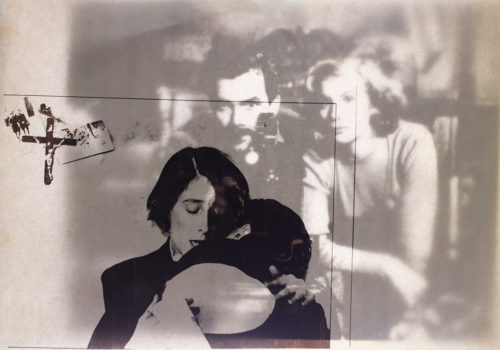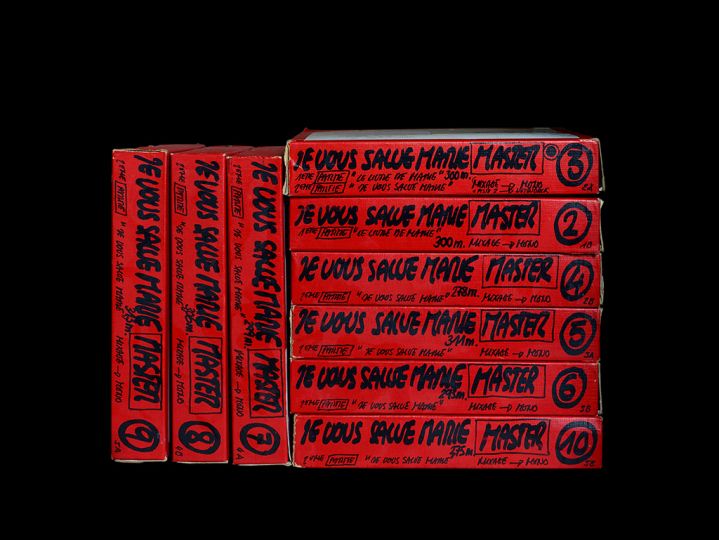A movie set.
Sounds that never saw the light of day and never left those moments behind the camera, facing the actors, inventing a shot, an image.
Stephan Crasneanscki was offered access to sound fragments from the shooting sets of Jean-Luc Godard, but also to an entire documentation that helps explain what nourished the film director.
What We Leave Behind, what he discovered, sort of by accident, reveals part of the director’s archives, the part fallen into oblivion, even dismissed…
It is also a portrait of contemporary cinema, a reflection about the archive, a loose reinvention through editing and pasting of moments of cinema that emerged from the collision of literature, visual arts and music that Godard was the first to bring together.
A composite piece, What We Leave Behind is Stephan Crasneanscki’s gaze over these forgotten items; objects that hold thought matter within, waiting only to be revealed. So the artist observed, recomposed, and in turn, induces perception.
“To be, is to be perceived,” claims Berkeley, and the being of objects is to be perceived, in the same way that of subjects is to perceive.
Film reels, books, notes, videocassettes, piles of information, clues, all offered to his gaze and evoking cinema’s memory through its various formats.
Through film, sound and photography, Stephan Crasneanski brings in an imaginary world linked to Godard’s thought, and restitutes an experience.
He delivers clues, and asks: A tree falling in the forest, does it make noise if no one is there to listen?
Does the spirit create what it observes? And what happens when deprived of observation? Archives plunged into unending silence?
What does a reel with the inscription “Nouvelle vague” hide? A new cinema, a revolution? The open book of an era, a poetic and sociological testimony?
Obviously, there are the insiders, those who have seen, and are able to decipher and call for a flow of the films’ images.
There is Crasneanscki’s photographic eye, which re-contextualizes that memory.
But there is also an imagining force, creation as (re)creation of mosaic pieces that creates breaches, opening a world to be discovered.
Aren’t quotes, paraphrases or copies often used by famous artists?
Julien D’Abrigeon asserts that “(Picasso and Godard), both “pasters”, share some aesthetic similarities, the same fragmented perception of the body, of the world re-transcribed in their representations, the same aim at total, comprehensive description, the same use of flat colors, three colors (Le Mépris…), and black and white (Guernica, of course) but also a recurring use of stripes: Jacqueline aux mains croisées (1954) and the stripes of Michel and Patricia in A bout de souffle; Angela’s dressing gown in Une femme est une femme; B.B.’s sweater in Le mépris, etc. (Godard as a precursor of Daniel Buren?).”
Godard’s cinema should be conceived as a whole and no art is excluded from his projects. “Godard is Delacroix” would marvel Aragon who had acknowledged cinema as a plastic art, recalls Julien D’Abrigeon.
The minimalist compositions in What We Leave Behind can also evoke a history of abstract art: Donald Judd, Malevitch or even Sol Lewitt with some Progressive Structure. Again, the thought matter within – the forgotten archives rearticulated in a mise en abyme of collage and quotation.
Godard’s pieces are complex, and such are many artists’ pieces, that collide and that Crasneanscki invites us to explore. Are the piles of videocassettes of Soigne ta droite annotated with a black felt-pen, the keys of a piano, the evocation of a world connected to music, or the recollection of some political commitment, which may have inhibited that of the artist?
Recalling Lotta continua, a Maoist, communist and revolutionary political group, with the image of a man waving a weapon, surrounded by his companions, as the inscription Lotta continua surges from a composition of dark boxes split however by a sparkle of red.
Godard is the starting point, the one who has read, listened to, watched, created, and has led Stephan Crasneanscki to pursue a path in order to reveal and produce a game out of this living matter, this memory.
EXHIBITION
Stephan Crasneanscki, What we leave behind
Jean-Luc Godard’s archives
From January 9 to February 27 2016
Galerie Odile Ouizeman
10/12 rue des Coutures St Gervais
75003 Paris
France
+ 33 1 42 71 91 89
[email protected]
http://www.galerieouizeman.com



















